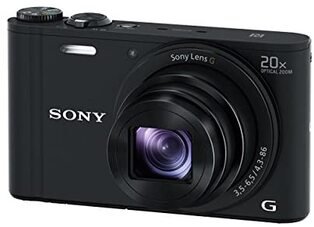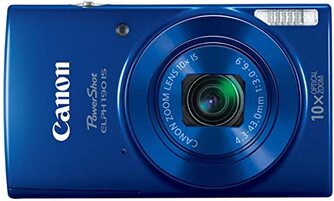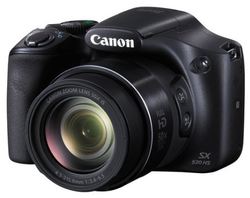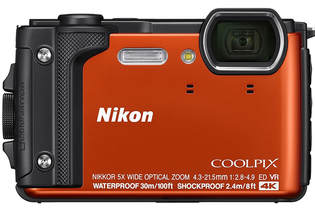Compact Digital Cameras-Point and Shoot Cameras
 Sony DSCWX350 18 MP Digital Camera
Sony DSCWX350 18 MP Digital Camera
Choosing the best camera to buy might be a little overwhelming to some people. That is probably because there are so many types of cameras on the market with so many different features to choose from. In this article we will list the main features found in Compact Digital cameras which are also known as Point and Shoot cameras.
They are called point and shoot cameras because all you have to do is point the camera at the subject and shoot the picture. The exposure settings for the shutter speed, the lens aperture, and light sensitivity (ISO) are automatically set by the camera. So the Compact Digital camera is ideal for those who are not concerned about manually controlling those settings.
Point and Shoot cameras like the Sony DSCWX350 shown here are by far the most widely used type of consumer cameras. The main features of these type cameras are their smaller size, ease of use, and affordable pricing.
The quality of the images taken by compact digital cameras is very good and is usually more than acceptable for the average photographer.
Many of the features that are standard on just about any Compact Digital Camera are listed below.Those are followed by a few extra features that may or may not be important to you when choosing a Compact Digital Camera.
They are called point and shoot cameras because all you have to do is point the camera at the subject and shoot the picture. The exposure settings for the shutter speed, the lens aperture, and light sensitivity (ISO) are automatically set by the camera. So the Compact Digital camera is ideal for those who are not concerned about manually controlling those settings.
Point and Shoot cameras like the Sony DSCWX350 shown here are by far the most widely used type of consumer cameras. The main features of these type cameras are their smaller size, ease of use, and affordable pricing.
The quality of the images taken by compact digital cameras is very good and is usually more than acceptable for the average photographer.
Many of the features that are standard on just about any Compact Digital Camera are listed below.Those are followed by a few extra features that may or may not be important to you when choosing a Compact Digital Camera.
 Canon PowerShot Elph 190
Canon PowerShot Elph 190
Full Automatic Mode: Using a Compact Digital Camera is pretty easy. Just turn it on, set it to the automatic mode or one of the scene modes and just start taking pictures. All compact cameras have auto focus and automatic exposure settings which will usually produce some pretty nice images. Once again, that is why they are also known as point and shoot cameras.
Automatic Scene Modes: Compact Digital cameras come with a wide variety of scene mode settings. Just choose the type scene you will be taking pictures of and the camera will automatically set the proper exposure for that type of scene. The amount and type of scene modes will vary from camera to camera. Some of the most common scene modes are landscape, portrait, close up, panoramic, sports, fireworks and beach/snow.
Macro Mode: This mode is designed to take very detailed close up pictures of a subject. Flowers are probably the most popular subject taken using this mode, but it can be used to take pictures of any small object or area.
Size/Colors: Most Compact Digital cameras are small enough to carry in a pocket or purse. The Slim models like the Canon Powershot Elph 190 are popular due to their small size. Some slim compact cameras can fit into a shirt pocket comfortably.
Many Compact Digital cameras come in a variety of colors for those who might want a camera that is also a fashion accessory.
Zoom Lens: All basic compact cameras come with a zoom lens that has a minimum three time (3X) magnification. That will enable you to take pictures from a wide angle to medium telephoto range.
When considering the zoom length, always pay attention to the optical zoom length. The digital zoom length might be longer, but the quality of pictures is not as good in the digital zoom range.
Some Compact Digital cameras have an extremely high zoom range. These type of cameras are also known as Super Zoom cameras or Bridge Cameras. Some of them are also shaped like a Digital SLR camera but are more compact. The Canon Powershot SX530 HS shown below has a 50X optical zoom and is a good example of a Super Zoom or Bridge camera.
Automatic Scene Modes: Compact Digital cameras come with a wide variety of scene mode settings. Just choose the type scene you will be taking pictures of and the camera will automatically set the proper exposure for that type of scene. The amount and type of scene modes will vary from camera to camera. Some of the most common scene modes are landscape, portrait, close up, panoramic, sports, fireworks and beach/snow.
Macro Mode: This mode is designed to take very detailed close up pictures of a subject. Flowers are probably the most popular subject taken using this mode, but it can be used to take pictures of any small object or area.
Size/Colors: Most Compact Digital cameras are small enough to carry in a pocket or purse. The Slim models like the Canon Powershot Elph 190 are popular due to their small size. Some slim compact cameras can fit into a shirt pocket comfortably.
Many Compact Digital cameras come in a variety of colors for those who might want a camera that is also a fashion accessory.
Zoom Lens: All basic compact cameras come with a zoom lens that has a minimum three time (3X) magnification. That will enable you to take pictures from a wide angle to medium telephoto range.
When considering the zoom length, always pay attention to the optical zoom length. The digital zoom length might be longer, but the quality of pictures is not as good in the digital zoom range.
Some Compact Digital cameras have an extremely high zoom range. These type of cameras are also known as Super Zoom cameras or Bridge Cameras. Some of them are also shaped like a Digital SLR camera but are more compact. The Canon Powershot SX530 HS shown below has a 50X optical zoom and is a good example of a Super Zoom or Bridge camera.
 Canon Powershot SX530 HS with 50X Zoom Lens
Canon Powershot SX530 HS with 50X Zoom Lens
Exposure Compensation EV+/-: This feature allows you lighten or darken your pictures if they are coming out underexposed or overexposed. The exposure compensation feature allows you to override the cameras' automatic exposure settings. Check the tutorial on Exposure Compensation for more on how this works.
Built in Flash/Self Timer: A built in flash is standard in most compact cameras. The flash will assist in taking pictures indoors or in low light situations. Self timers which allow you to include yourself in a picture are also standard in compact cameras.
Movie/Video Mode: Just about every compact camera will have a movie/video mode. The movie mode is good for making short videos but is not meant to replace regular video cameras. Most basic compact cameras will shoot video at 720p. However, many compact cameras are now able to shoot at 1080p for better quality HD viewing.
Image Stabilization: Using the image stabilization feature will reduce some of the blur that might result from camera shake or movement when the camera shutter is pressed.
White Balance: Sometimes pictures have an unwanted color tint in them. The white balance feature lets you make adjustments so that your images look more natural. Read the tutorial, White Balance to learn more.
Megapixels: Do not get caught up in the number of Megapixels a camera has. Most of todays Compact Digital cameras have at least 10 Megapixels. That is more than enough for a 10X13 size print. The quality of your pictures is not solely dependent upon the number of Megapixels that your camera has. Take a look at the article Digital Camera Pixels if you would like to know more about cameras and megapixels.
The above mentioned features are all you really need in a compact digital camera to start taking pictures. However, there is stiff competition among the camera manufacturers. So they make extra features available in their cameras in order to get an edge over their competition.
The following are some additional features that are found in many, but not every Compact Digital camera.
Large LCD Viewing Screen/Touchscreen: All Compact cameras have a viewing screen that is at least 2.5 inches. Some Compact cameras have larger 3.5 screens that make viewing easier.
Some basic compact cameras in the lower price range may not have touchscreens. However, the Canon Powershot GX9 , is an advanced compact camera equipped with a touchscreen.
Built in Flash/Self Timer: A built in flash is standard in most compact cameras. The flash will assist in taking pictures indoors or in low light situations. Self timers which allow you to include yourself in a picture are also standard in compact cameras.
Movie/Video Mode: Just about every compact camera will have a movie/video mode. The movie mode is good for making short videos but is not meant to replace regular video cameras. Most basic compact cameras will shoot video at 720p. However, many compact cameras are now able to shoot at 1080p for better quality HD viewing.
Image Stabilization: Using the image stabilization feature will reduce some of the blur that might result from camera shake or movement when the camera shutter is pressed.
White Balance: Sometimes pictures have an unwanted color tint in them. The white balance feature lets you make adjustments so that your images look more natural. Read the tutorial, White Balance to learn more.
Megapixels: Do not get caught up in the number of Megapixels a camera has. Most of todays Compact Digital cameras have at least 10 Megapixels. That is more than enough for a 10X13 size print. The quality of your pictures is not solely dependent upon the number of Megapixels that your camera has. Take a look at the article Digital Camera Pixels if you would like to know more about cameras and megapixels.
The above mentioned features are all you really need in a compact digital camera to start taking pictures. However, there is stiff competition among the camera manufacturers. So they make extra features available in their cameras in order to get an edge over their competition.
The following are some additional features that are found in many, but not every Compact Digital camera.
Large LCD Viewing Screen/Touchscreen: All Compact cameras have a viewing screen that is at least 2.5 inches. Some Compact cameras have larger 3.5 screens that make viewing easier.
Some basic compact cameras in the lower price range may not have touchscreens. However, the Canon Powershot GX9 , is an advanced compact camera equipped with a touchscreen.
 Nikon W300 Waterproof Underwater Digital Camera
Nikon W300 Waterproof Underwater Digital Camera
Outdoor/Active Lifestyle: If you will be taking lots of pictures in active outdoors situations, a rugged camera like the Nikon W300 Waterproof camera might be a good fit for you. It is a waterproof (to 100 Ft) digital camera that is also shockproof (from falls up to 7.9 Ft. These type cameras are also ideal if young children might be handling them.
Wl-Fi Function: You can now share your photos using wireless functions that are built into the camera. With certain camera models you can upload pictures to social network sites as well as sync your camera to smart devices.That includes TV, tablets, computers, and phones.
Pricing: The price of most point and shoot cameras range from under $100 to around $500. The difference in the price you pay will depend on the overall quality of the particular camera as well as the amount of extra "bells and whistles" that you are willing to pay for.
Compact digital cameras produce very good images and are great for everyday general photography. They are the best camera for people who want simplicity when it comes to taking pictures. Compact digital cameras are also the best choice for those who don't want to spend a lot of money on a camera.
A point and shoot camera is probably the best camera for beginners who just want to see if photography is something they are really interested in.
It is interesting to note that even professional photographers carry a compact camera with them when they are not working on a project "just in case" a great photo opportunity arises.
Now that you are familiar with the basic features of compact digital cameras, you should be able to determine if this is the best type of camera for you.
Wl-Fi Function: You can now share your photos using wireless functions that are built into the camera. With certain camera models you can upload pictures to social network sites as well as sync your camera to smart devices.That includes TV, tablets, computers, and phones.
Pricing: The price of most point and shoot cameras range from under $100 to around $500. The difference in the price you pay will depend on the overall quality of the particular camera as well as the amount of extra "bells and whistles" that you are willing to pay for.
Compact digital cameras produce very good images and are great for everyday general photography. They are the best camera for people who want simplicity when it comes to taking pictures. Compact digital cameras are also the best choice for those who don't want to spend a lot of money on a camera.
A point and shoot camera is probably the best camera for beginners who just want to see if photography is something they are really interested in.
It is interesting to note that even professional photographers carry a compact camera with them when they are not working on a project "just in case" a great photo opportunity arises.
Now that you are familiar with the basic features of compact digital cameras, you should be able to determine if this is the best type of camera for you.